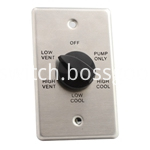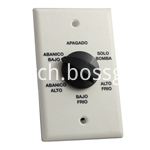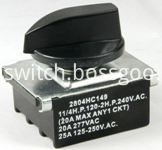1. Qtc: the total Q value of the whole system of the speaker,
Second, the loss Q value of the cabinet:
Ql-Leakage loss Q value. Leakage caused by poor sealing of the cabinet and unit, usually this has a greater impact on the inverter box. The general value is 5-20, which is difficult to predict. 5 indicates that the seal is very good! The default value is usually 10.
Qa-The Q value of absorption loss, which is caused by the absorption of sound waves by the box, and the filler in the box will greatly enhance the absorption. The inner wall of a dry and smooth rigid box is usually about Qa = 30-100, and when it is filled in a large amount, it will reach 3-5.
Qp-Inverter tube loss, caused by the inverter tube, due to the friction of the tube wall when the air passes, the inverter tube will have some damping. In fact, if you set this Q value to very small (meaning that the damping is very Large), the inverter box will become a closed box, huh, huh.
Off-topic, --- understanding of Q value: (Q value is generally directly translated into quality factor, this name is a bit puzzling for rookie ...)
The Q value is a mathematical quantity that describes the resonance situation. It is always introduced to everyone with the concept of damping (in a resonance system), or someone introduces it as a damping value. For a resonant system, the greater the damping, the more the resonance of the system is clamped, resulting in a low-Q resonance curve. When the damping is small, the situation is reversed and the resonance is intense, forming a high-Q curve.
In general, for speaker systems, the appropriate Q value is between 0.5-1.5. When it is lower than 0.5, the damping is too strong, and no resonance occurs at this time. Therefore, it is also said that 0.5Q value is called critical damping, and the smallest Q value is called overdamping. Conversely, if Q is greater than 1.5, it can be called underdamping.
On the frequency-amplitude curve of the resonant system, we can intuitively see the curves represented by different Q values ​​and the meaning of different Q values.
Speaker Q
Qes is the electric Q value of the horn, which reflects the resonance capability of the unit under electromagnetic control at Fo. The lower the value, the stronger the damping and the smaller the system resonance.
Qms is the mechanical Q value of the speaker. It reflects the unit's ability to resonate with respect to the mechanical structure at Fo. The lower the value, the stronger the damping and the smaller the system resonance.
Qts is the total Q value of the horn (formed by the parallel coupling of Qms and Qes). It reflects the resonance capability of the unit at Fo. The lower the value, the stronger the damping.
The system's Q value of the whole system refers to the power amplifier output, speaker cable, and speaker. This is an actual Q value at work. Compared with the Q value of the cabinet Qtc, the damping factor is added here.
The influence of the damping coefficient includes the output damping coefficient of the power amplifier, the damping coefficient of the speaker wire, the damping coefficient of the series-connected speakers (if any), and the damper coefficient of the crossover.
Therefore, in order to ensure that the Q value design of the original box is not affected, the general power amplifier requires the damping coefficient to be as small as possible, at least 10 or more, but generally 100 or more. The frequency divider is mainly affected by the resistance of the inductor, generally speaking more than 20. The wire should also be as small as possible.
For series-connected speakers, the damping coefficient is inevitably higher than 1, so the general design is to connect speakers in parallel.
Damping and Q value both describe the working situation of the unit near the resonance point, that is, the change of sound generation near the resonance point, which has basically no effect on the frequency response of other frequency regions.
Of course, there are some in-depth details, depending on the specific unit.

Follow WeChat

Download Audiophile APP

Follow the audiophile class
related suggestion


